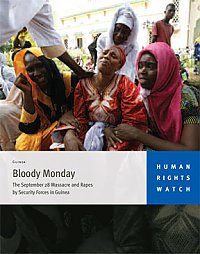MINUSTAH by the Numbers, Center for Economic and Policy Research |
 |
| Thursday, 08 December 2011 14:19 |
|
The United Nations Peacekeeping operation in Haiti, MINUSTAH by its French acronym, has been the target of recent popular protests and a source of controversy because of its role in re-introducing cholera to Haiti, the sexual assault of a young Haitian man and other past abuses. On November 3, 2011 the Institute for Justice and Democracy in Haiti and Bureau des Avocats Internationaux filed a legal complaint on behalf of over 5,000 cholera victims seeking damages from the United Nations. The UN has so far not responded or given a timetable for a response. Here is MINUSTAH, by the numbers: Percent of worldwide UN peacekeepers that are in Haiti, despite it not being a war zone: 12.5 Number of MINUSTAH troops (military and police) currently in Haiti: 12,552 Rank in size among the 16 UN peacekeeping operations worldwide: 3 Rank in size of Darfur and the Democratic Republic of Congo, respectively: 1, 2 Percent of Haiti’s annual government expenditures to which MINUSTAH’s budget is equivalent: 50 Percent of Haiti’s GDP to which MINUSTAH’s budget is equivalent: 10.7 Total estimated cost of MINUSTAH since the earthquake: $1,556,461,550 Percent of UN peacekeeping operations worldwide funded by the United States: 27 Percent the U.S. has disbursed out of its $1.15 billion pledge at the March 2010 donor conference: 18.8 Factor by which MINUSTAH’s budget exceeds the amount of funds the UN’s cholera appeal has raised: 8 Percent of MINUSTAH’s budget it would take to fully fund the UN’s cholera appeal: 1.7 Number of days operating expenses it would take to fund a cholera vaccination campaign that would cover the entire country: 18 Percent of a single day’s MINUSTAH budget that the cholera vaccination pilot program will use over its multiple-week lifespan: 40 Minimum number of people killed from cholera in Haiti since October 2010: 6,908 Number of people killed by homicide in Haiti in 2010: 689 Number of people, per 10 million (roughly the population of Haiti), killed by homicide in Brazil, the largest troop contributor to MINUSTAH: 2,270 Number of cholera victims who filed a claim with the UN seeking damages: 5,000 Number of cholera victims: 513,997 Rate per minute that Haitians were falling ill with cholera in July 2011: 1 Amount by which MINUSTAH’s budget exceeds the UN’s 2012 humanitarian appeal for Haiti: $562,517,100 Number of MINUSTAH personnel who were repatriated this year after a cell phone video emerged showing troops sexually assaulting a young Haitian man: 5 Number of successful prosecutions against over 100 MINUSTAH troops repatriated to Sri Lanka after allegations of involvement in child prostitution surfaced in 2007: 0 Number of standing claims commissions set up by the UN under Status of Forces Agreements so that local population may have means of redress from peacekeepers, historically: 0 Years MINUSTAH has been in Haiti: 7 Shortfall in trained national police officers that are supposed to take over for MINUSTAH: 10,000 Date on which cholera was discovered: October 21, 2010 Date the head of MINUSTAH was reported saying it was “really unfair” to accuse the UN of bringing cholera to Haiti: November 22, 2010 Distance, in miles, from the Nepalese MINUSTAH base to the location of the first reported case of cholera: .1 Date on which scientific paper confirmed that Haitian and Nepalese samples of cholera were “almost identical”: August 23, 2011 Days since the cholera outbreak it has taken for the UN to accept responsibility: 413 (and counting) Date on which MINUSTAH’s mandate was extended through 2012: October 14, 2011 Percent of Haitians in a recent survey who said they wanted MINUSTAH gone within a year: 65
With due respect to Harper’s. Tags: minustah |




Chico
December 15, 2011
Many valid statistics…but this doesn’t really say anything?! And in some cases presents info in a disingenuous light because there is no substance explaining or qualifying the context.
First: Haiti is NOT occupied. The MINUSTAH is invited and only allowed to remain with the Haitian governments consent. If and when Haiti’s sovereign government decides it is time, the MINUSTAH is obligated to withdraw.
Second: Your stats on UN Peackeeping military troops in Haiti compared to “War Zones” is misleading. The gross figure does not show the difference in number of “combat troops” as compared to engineers, support and logistics officers. There is a difference between the ratio of technical brigades, that are non-combat in nature in Haiti, such as those that are repairing and building roads or removing rubble, as compared to “war zones” such as the DRC, Sudan, where the vast majority of peacekeepers are either combat or direct support personnel.
Third: While admittedly the MINUSTAH’s operating costs are expensive and higher than the cholera appeal funding…this is no clear relationship between the two. There is not causal link in suggesting that more money would go to cholera appeal if the MINUSTAH was not there. This is a counter factual argument, and cholera response does not require that much money.
Fourth: Cholera vaccination program? Umm….you want anyone to use a scientifically unreliable vaccination drive for cholera in Haiti that is also difficult to administer (requiring normally two separate administrations and has only short-term affects, instead of just focusing on basic hygiene and sanitation? Is that what you are suggesting? An inefficient cholera vaccination program would probably cause even more problems, deaths and violence. Whereas simple, cheap and sustainable hygiene and sanitation programs and sensitization would not only protect Haitians from cholera, but all sorts of other endemic diseases and sicknesses that have affected the population for the past hundred years. There is probably a reason why the “Pilot Vaccination Programme” is not getting money, because it is not proven and not sustainable – compared to having people just wash their hands, prepare they food and drinking water hygienically, etc…
Fifth: the issues of standing claims and prosecution of MINUSTAH peacekeepers is not looking at the broader issue. In all peacekeeping operations the MoU or Status of Force agreement prevents soldiers from being prosecuted by the host nation. Not one country would ever expose their troops to this due to the potential political manipulations. Pointing this out is just for MINUSTAH is myopic, the issue is ensuring that those countries that contribute troops in turn court marshal or use civilian trial for perpetrators at a global/UN Secretariat level. This is a structural issues, not Haiti being victimized.
Sixth and MOST IMPORTANT: This kind of presentation regarding the situation in Haiti is not constructive towards actual debate about the problems confronting the population. It is almost a simplified “neo-colonial” perspective that suggests that the Haitian people have no control, capacity or intent to change their OWN lives, or that the MINUSTAH is the barrier that is preventing real progress. I would love to hear this much attention on why corruption is so high in Haiti’s government, why it is so inefficient, why so many rich Haitians are tax-evaders…but more importantly, debate should be on what Haiti’s local population believe are their priorities and what they believe their own government and their communities should do about it.
Just pointing the finger at the MINUSTAH is almost meaningless.The problems in Haiti are far beyond the scope, capacity and financing of the MINUSTAH. If the MINUSTAH was to leave tomorrow, would that solve Haiti’s problems? No, a quick withdrawal would create economic havoc. Thousands of Haitians would lose direct and indirect jobs…instead an interesting article would be on identifying how the MINUSTAH’s progressive withdrawal should be tied with concrete, objective and measurable achievements on the part of both national and local government in order to ensure a smooth transition for the economy, security, human rights and governmental transparency.
Sincerest regards,
Chico
Haiti Frozen
December 20, 2011
“Data are not information! To determine what statistical data analysis is, one must first define statistics. Statistics is a set of methods that are used to collect, analyze, present, and interpret data. Statistical methods are used in a wide variety of occupations and help people identify, study, and solve many complex problems. In the business and economic world, these methods enable decision makers and managers to make informed and better decisions about uncertain situations. ”
http://home.ubalt.edu/ntsbarsh/stat-data/topics.htm#rwsaq